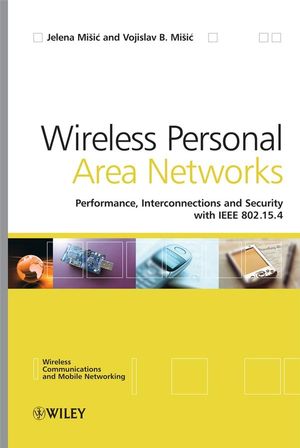Wireless Personal Area Networks: Performance, Interconnection and Security with IEEE 802.15.4ISBN: 978-0-470-51847-2
Hardcover
336 pages
February 2008
 This is a Print-on-Demand title. It will be printed specifically to fill your order. Please allow an additional 10-15 days delivery time. The book is not returnable.
|
||||||
About the Series Editors xi
List of Figures xiii
List of Tables xvii
Preface xix
Part I WPANS and 802.15.4 1
1 Prologue: Wireless Personal Area Networks 3
1.1 Wireless Ad Hoc Networks 3
1.2 Design Goals for the MAC Protocol 4
1.3 Classification of MAC Protocols for Ad Hoc Networks 6
1.4 Contention-Based MAC Protocols 9
1.5 New Kinds of Ad Hoc Networks 12
1.6 Sensor Networks 12
2 Operation of the IEEE 802.15.4 Network 17
2.1 Physical Layer Characteristics 17
2.2 Star Topology and Beacon Enabled Operation 20
2.3 Slotted CSMA-CA Medium Access 22
2.4 Acknowledging Successful Transmissions 24
2.5 Downlink Communication in Beacon Enabled Mode 25
2.6 Guaranteed Time Slots 28
2.7 Peer-to-Peer Topology and Non-Beacon Enabled Operation 29
2.8 Device Functionality and Cluster Formation 31
2.9 Format of the PHY and MAC frames 35
Part II Single-Cluster Networks 39
3 Cluster with Uplink Traffic 41
3.1 The System Model – Preliminaries 41
3.2 Superframe with an Active Period Only 44
3.3 Superframe with Both Active and Inactive Periods 51
3.4 Probability Distribution of the Packet Service Time 57
3.5 Probability Distribution of the Queue Length 59
3.6 Access Delay 61
3.7 Performance Results 65
4 Cluster with Uplink and Downlink Traffic 71
4.1 The System Model 71
4.2 Modeling the Behavior of the Medium 84
4.3 Probability Distribution for the Packet Service Time 86
4.4 Performance of the Cluster with Bidirectional Traffic 91
5 MAC Layer Performance Limitations 95
5.1 Congestion of Packets Deferred to the Next Superframe 95
5.2 Congestion after the Inactive Period 98
5.3 Congestion of Uplink Data Requests 99
5.4 Blocking of Uplink Data and Data Requests 100
5.5 Possible Remedies 102
6 Activity Management through Bernoulli Scheduling 111
6.1 The Need for Activity Management 111
6.2 Analysis of Activity Management 112
6.3 Analysis of the Impact of MAC and PHY Layers 116
6.4 Controlling the Event Sensing Reliability 121
6.5 Activity Management Policy 123
7 Admission Control Issues 131
7.1 The Need for Admission Control 131
7.2 Performance under Asymmetric Packet Arrival Rates 133
7.3 Calculating the Admission Condition 135
7.4 Performance of Admission Control 139
Part II Summary and Further Reading 143
Part IIIMulti-cluster Networks 145
8 Cluster Interconnection with Master-Slave Bridges 147
8.1 Analysis of Bridge Operation 149
8.2 Markov Chain Model for a Single Node 158
8.3 Performance of the Network 165
8.4 Network with a Single Source Cluster/Bridge 166
8.5 Network with Two Source Clusters/Bridges 173
8.6 Modeling the Transmission Medium and Packet Service Times 179
9 Equalization of Cluster Lifetimes 187
9.1 Modeling the Clusters 187
9.2 Distributed Activity Management 190
9.3 Energy Consumption in Interconnected Clusters 194
9.4 Performance of Activity Management 198
10 Cluster Interconnection with Slave-Slave Bridges 203
10.1 Operation of the SS Bridge 205
10.2 Markov Chain Model for the SS Bridge 217
10.3 Markov Chain for Non-Bridge Nodes 224
10.4 Performance Evaluation 230
10.5 To Acknowledge or Not To Acknowledge: The CSMA-CA Bridge 231
10.6 Thou Shalt Not Acknowledge: The GTS Bridge 234
10.7 Modeling the Transmission Medium and Packet Service Times 240
Part III Summary and Further Reading 251
Part IV Security 253
11 Security in 802.15.4 Specification 255
11.1 Security Services 256
11.2 Auxiliary Security Header 257
11.3 Securing and Unsecuring Frames 258
11.4 Attacks 260
12 The Cost of Secure and Reliable Sensing 265
12.1 Analytical Model of a Generic Key Update Algorithm 267
12.2 Analysis of the Node Buffer 273
12.3 Success Probabilities 276
12.4 Key Update in a Multi-Cluster Network 278
12.5 Cluster Lifetime 280
12.6 Evaluation of Lifetimes and Populations 283
Part IV Summary and Further Reading 287
Appendices 289
Appendix A An Overview of ZigBee 291
A.1 ZigBee Functionality 291
A.2 Device Roles 292
A.3 Network Topologies and Routing 293
A.4 Security 295
Appendix B Probability Generating Functions and Laplace Transforms 301
Bibliography 302
Index 311



